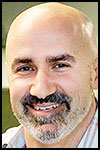Author shares glimpse into life on the street
Jason Peterson, 32, was shot and killed Feb. 20, 2017, outside the Golden Key Insurance Agency office in Portland. He left some belongings in front of the business just as the owner decided that he’d — to use words one hears frequently these days — “had enough.”
Ryan Dowd, an attorney, author, consultant and holder of a master’s degree in public administration, told McMinnville city staff members during a May 28 training session that people have valid reasons to fear homelessness — if they happen to be homeless.
A report issued in December by the National Coalition for the Homeless documents 1,769 assaults perpetrated on homeless people by mainstream citizens in 2017. The report indicated such crimes occurred in 48 states and 476 of the victims died.
“Society poses much more danger to homeless people than the other way around,” Dowd told the staff group, gathered at the McMinnville Community Center.
Just hours later, a crowd filled the same room to testify that people living in tents and RVs threaten the health and safety of the community. Included in the comments were concerns of how homeless people are allowed unfettered access to the public library.
Local librarians, however, remain unconvinced of any problems. Perhaps it’s because they’d heard from Dowd before.
In addition to operating a consulting business, Dowd serves as executive director of a large homeless shelter outside Chicago. And he is the author of “The Librarian’s Guide to Homelessness.”
The American Library Association published Dowd’s book last year. It contains a practical day-to-day guidance for librarians dealing with people living on the street nearby.
Library Director Jenny Berg and her staff attended a training session offered by Dowd. Berg was so impressed she suggested he be invited to address a broader cross-section of city employees.
The most common mistake people make in confronting the homeless is assuming people living on the streets are aberrations to the norm, Dowd said, predicated on a belief there is a baseline set of social and psychological rules everyone recognizes.
He said street people — by choice, mental illness or a combination of the two — live by entirely different standards. They just don’t realize it. They assume their mindset is the default for all humanity.
There’s nothing unusual about that, he said. The housed portion of the population believes the same, triggering misunderstandings.
“We assume everyone is exactly like us,” Dowd said. “We don’t take into account cultural and individual diversity.”
The key to understanding the homeless world is how it is fraught with danger, both from the outside world and their similarly homeless neighbors.
“Homeless individuals have experienced far more violence and danger than you and I ever have,” Dowd said.
As a result, they assess risk differently from others. They assume everything is a threat rather than risk being mistaken.
This attitude extends to perceived slights.
If a stranger bumps into an average person, he or she probably writes it off as an accident. In the homeless world, however, a bump might be a test for weakness, a deliberate act to determine if the other person is vulnerable.
Street people live by the code of the playground, Dowd said. If you establish yourself as the toughest kid, no one will mess with you.
It’s one reason why homeless people often look scary, he said. They don’t want people hassling them and they don’t differentiate among various levels of threat.
Whether real or simply perceived, threats provoke an emotional response from the amygdala section of the brain.
The amygdala region has no capacity for language, Dowd said. It can only react.
The brain relies on the logical hippocampus to calm the amygdala.
Human beings, regardless of their housing status, often ignore the hippocampus and listen to the amygdala. “They misperceive threat stimuli,” Dowd said.
This can be people in the homeless community perceiving everything in the outside world as a threat, but it can also work in reverse. It can result in people in the outside world sensing everyone in the homeless community is a threat.
The phenomenon also affects internal relationships among street people.
Based on a study, the National Institutes of Health estimates 25% of them suffer from some form of mental illness.
As a result, Dowd said, “They often cannot self-regulate their emotions. They stay angry longer.”
If people are homeless because they’re mentally ill, they’re also mentally ill because they’re homeless. People exposed to danger repeatedly over an extended period of time develop continuous traumatic stress disorder, known as CTSD, as a response.
CTSD as a concept originally developed in the 1980s by a group of psychologists working with victims of apartheid in racially segregated South Africa.
Children on the autism spectrum experience something similar, Dowd said.
They try to be “good,” but are nonetheless punished for their behavior. This happens repeatedly until they decide they are no longer going to try because they’ll get punished no matter what.
As a result, he said, it’s extremely difficult for a community like McMinnville to deal with homelessness by punishing the homeless. The usual punishments just don’t work.
People who live day by day also have a significantly different perception of time. They have what Dowd called a different “time horizon.”
They generally only think about 24 hours ahead. Authorities may try to heap punishment on them, but adding time to that punishment means nothing to do them.
Dowd said it’s the difference between giving someone a 200-year prison sentence or a 300-year prison sentence. There is no meaningful distinction.
“Human beings are lousy at making plans beyond their own time horizons,” Dowd said, even if they think in terms of decades or the rest of their lives instead of 24-hour increments.
That’s why people have trouble dealing with the climate crisis, he said — because the worst effects won’t become obvious until after they’re dead. They are more concerned with immediate situations, particularly economic ones.
People who don’t know where they’re going to sleep tonight have even greater compressed time horizons. “If I have to sleep outdoors tonight, and it’s minus 10 degrees, I don’t care where I’m going to sleep next summer,” Dowd noted.
While middle- to upper-class Americans live in what anthropologists call a dignity culture, street people live in what’s called an honor culture, and the rules are very different. “The problem is when these two worlds overlap,” Dowd said.
People in an honor culture rely on themselves rather than social institutions. “You’re not using the court system to advance your rights because that takes a lawyer and lawyers cost money,” he said.
Dowd recalled how a man living in his shelter was struck by a pickup in front of 40 witnesses, yet the police took no action in response.
“If that’s your experience, what do you do?” he said. “Do you call the police, or do you do what you have to?”
One woman told him she planned to hire bigger goons to beat up the goons that beat up her children. He explained how such action could result in her children being taken away from her.
She said she didn’t care. She couldn’t rely on the authorities, so she had to find another way to protect her children.
Dowd offers this basic advice for talking to people living on the street:
n Use small words, as many street people have limited education, thus respond better to simple words and clear questions.
n Pay attention to non-verbal cues. Street people read a great deal into body language, volume, tone and inflection.
n Value their possessions.
One person at the May 28 council meeting said people living on the streets didn’t have any real belongings, they just accumulated trash.
Dowd argues that point. It’s because they have so little, he said, that they value their possessions so much.
He said it’s important to understand the mentality of homeless people. But he noted understanding is not the same as excusing.
While the McMinnville Public Library welcomes everyone, including people who live on the street, bad behavior isn’t just brushed aside. People who disrupt the library — by misbehaving, not just by being poor and unsightly — are banned.
Dowd said any attempt to address homelessness must include understanding the problem, not simply embracing emotional assumptions and reactions. He said it’s important to know that people living on the street often react before thinking, responding angrily to misperceived threats.
And in that regard, the line between housed and unhoused can sometimes be quite fine.









Comments
Mike
Interesting. I liked the 'time horizon' concept.
OregonBorn
The homeless can get jobs, just like the rest of us.
Record unemployment at the moment.
Choices have consequences. Enabling them will not help them.
Drew1951
Many homeless people have no address. Many employers require such. Many homeless people, especially those with addiction issues, are not deemed “employable.” Many homeless people do not have access to transportation. In fact, there are homeless citizens who work but minimum wage at less than 40 hours per week would not be enough to pay rent, electricity and food. I am an extremely fortunate man but I realize that it would take only one tweak in my life to put me on the streets. I always try to think about how Jesus would treat our estranged brothers and sisters.
Joel
Nice stuff to think and talk about, Mr Dowd. I have a sneaking suspicion that you get paid (and probably a lot) to go around talking to librarians and city councils about homelessness. Got any specific, concrete, actionable, measurable solutions?
Stella
The News Register does its best by featuring stories like this one or the large article explaining why "Seattle is Dying" wasn't true or why we need a needle exchange (editorial written by someone who months later receives a contract with the county) or..
News Register Staff:
Let's do a front page article on the typical hard working Yamhill County taxpayer who works/or worked hard to make ends meet.